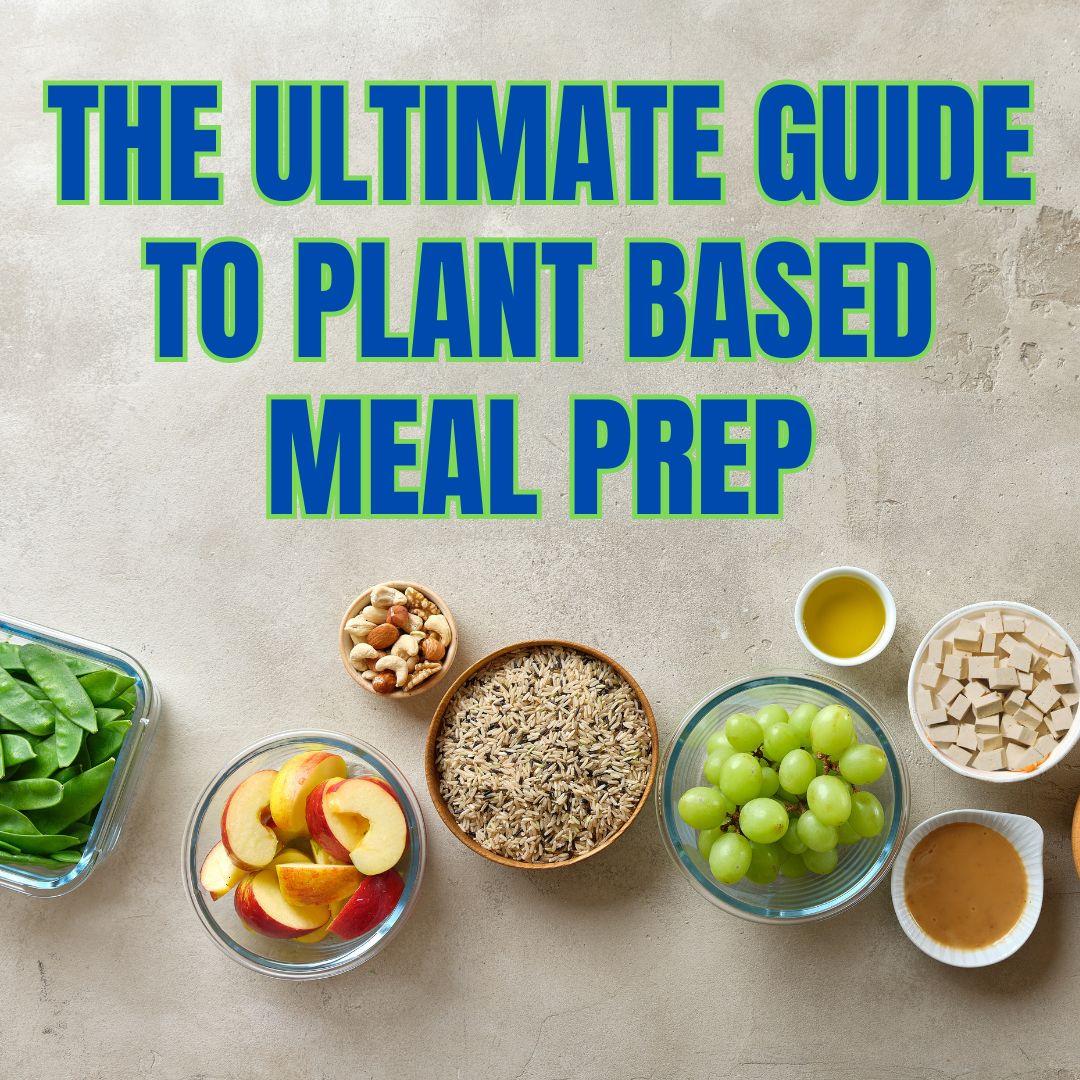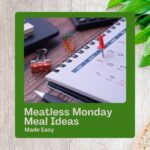Ever come home after a long day, starving, and realize there’s nothing ready to eat? That’s the exact moment plant-based meal prep saves the day. With a little planning, you can open your fridge and instantly have healthy, satisfying options waiting for you – no stress, no takeout.
Meal prepping on a plant-based diet isn’t just about saving time. It helps cut food waste, keeps your grocery bill lower, and makes sure you always have nourishing meals ready to go. Whether you’re 100% plant-based or just adding more plants to your plate, these tips will help you get started without feeling overwhelmed.
Plant-Based Meal Prep Tips You Can Use Right Away
Meal prep doesn’t have to be complicated – it’s really just about setting yourself up for success with a few smart habits. Start small, build on what works for you, and before long you’ll have a fridge full of ready-to-go meals and ingredients. Here are six simple tips to get you started:
1. Start with a simple plan.
Take a few minutes at the beginning of the week to look at your schedule and figure out where you’ll need meals ready. Don’t overthink it – just pick 3 or 4 dinners you enjoy and rotate them through the week. Write down the ingredients and turn that into your shopping list. For example: tacos on Monday, a grain bowl midweek, and a hearty soup for Friday. Easy, repeatable, and flexible.
2. Keep your staples stocked.
A well-stocked pantry and fridge make meal prep so much easier. Think canned beans, quinoa, brown rice, oats, nut butter, and frozen veggies. Every time you run low, add it to a running grocery list on your fridge or phone so you never get caught short. Here is our PLANT-BASED STAPLES & ESSENTIALS list.
3. Batch cook your basics.
Cook a pot of grains (like quinoa or brown rice) and a pot of beans on the weekend. Use them in different ways all week – quinoa in a salad, beans in tacos, rice under a curry. One cooking session, multiple meals.
4. Prep veggies ahead of time.
Chop up carrots, bell peppers, or cucumbers and keep them in airtight containers. Toss them into a quick stir-fry, snack on them with hummus, or throw them in a salad. A few minutes of chopping now saves you from grabbing chips later.
5. Get protein ready to go.
Cook up a block of tofu, tempeh, or seitan and keep it in the fridge. Marinate it for extra flavor, then use it in salads, wraps, or grain bowls. Having ready-to-eat protein makes meals come together in minutes.
6. Flavor is everything.
Make one or two sauces each week, like a lemon-tahini dressing or a simple vegan pesto. Drizzle them over bowls, salads, or roasted veggies to make even the simplest meal taste exciting.
Tools to Make Plant-Based Meal Prep Easier
The right tools can turn meal prep from a chore into something quick and efficient. You don’t need every gadget out there – just a few basics to keep things organized and stress-free.
- Glass or BPA-free containers: Store your prepped ingredients and meals in containers that are microwave and dishwasher safe. Pro tip: label them with painter’s tape before popping them in the fridge or freezer so you always know what’s inside.
- Mason jars: Perfect for overnight oats, layered salads, or storing homemade dressings.
- Instant Pot or slow cooker: A total lifesaver for beans, soups, and stews. Set it and forget it while you prep other foods.
- Sharp knives and cutting boards: Prepping vegetables goes so much faster (and safer) with good knives.
- Food processor or blender: Use these for sauces, dips, smoothies, or even chopping veggies in bulk.
- Spiralizer: Great for making zucchini or sweet potato noodles when you want a lighter pasta night.
- Kitchen scale: Handy for portioning and keeping meals balanced.
This WIRECUTTER GUIDE TO CUTTING DOWN FOOD WASTE ARTICLE is a great resource to dig a little deeper into useful meal prep kitchen tools.
Action Step: Start with the basics (containers, knives, and one appliance) and add on as you build your meal prepping routine.
How to Schedule Your Plant-Based Meal Prep
The best meal prep routine is the one that actually works with your life. Here are a few approaches to try:
- Weekend Warrior: Dedicate 2–3 hours on Sunday to cook grains, beans, proteins, and roast a few trays of veggies. Store everything separately so you can mix and match during the week. By Friday, you’ll be glad your past self put in the effort.
- Midweek Top-Up: If Sunday prep feels too big, do a mini-prep on Wednesday or Thursday night. Chop a batch of veggies, cook a grain, and make a sauce. This keeps ingredients fresh and gives you options for quick dinners.
- Balanced Approach: Prep most of your basics but leave a couple of nights for quick, 15-minute plant-based recipes like veggie stir-fries, grain bowls, or wraps. This keeps things flexible and prevents burnout.
- Theme Nights: Add fun to your routine with Mexican Monday, Italian Wednesday, or Asian Thursday. Prep specific sauces, grains, or proteins ahead of time so building meals around your theme feels effortless.
Action step: Pick one approach that matches your schedule this week and test it out. Adjust until you find your rhythm.
A Sample Plant-Based Meal Prep Week
Here’s an example of what your week might look like when you prep ahead for lunch and dinner:
- Sunday: Cook a pot of quinoa, roast a tray of vegetables, and make a big batch of HEARTY CHILI MAC. Store them in separate containers.
- Monday: Use quinoa for a loaded salad at lunch. Reheat chili mac for dinner.
- Tuesday: Assemble a quick salad with prepped veggies and seeds for lunch. For dinner, make a power bowl with roasted veggies, crispy air-fried chickpeas, and hot sauce.
- Wednesday: Prep overnight oats in mason jars for breakfasts. Use prepped quinoa and tofu for lunch. Dinner: microwave a baked potato, top with chili, and serve with extra roasted veggies.
- Thursday: Make a pot of DETOX VEGGIE SOUP, portion into containers, and store for easy lunches or dinners.
- Friday: Prep a couple of wraps or sandwiches with leftover veggies and proteins.
Action step: Try this exact schedule for one week, or swap in your favorite easy plant-based recipes. The goal is variety without extra effort.
Start Small with Lunch Prep
If you’re new to meal prepping, don’t feel like you have to prep every single meal right away. Lunch is an easy place to start:
- Mason jar salads: Layer greens, chopped veggies, beans, and a simple dressing at the bottom. Shake and eat.
- Veggie wraps: Use whole-grain tortillas or big lettuce leaves. Spread with hummus, add avocado and roasted veggies.
- Grain bowls: Start with quinoa or rice, add beans or lentils, veggies, and a drizzle of sauce.
Action step: Choose one lunch option this week and prep 2–3 portions in advance. See how much easier your afternoons feel.
Breakfasts & Snacks Made Simple
Lunches and dinners usually get all the attention in plant-based meal prep, but having quick breakfasts and snacks ready can make your week so much smoother. The key here is to keep things simple, instead of trying to prep seven different options, pick just two or three favorites to rotate each week.
Here are some easy ideas to get started:
- Overnight Oats – Mix rolled oats with plant-based milk and your favorite toppings (berries, nut butter, seeds). Make 3–4 jars at once so they’re ready to grab in the morning.
- Chia Pudding – Stir chia seeds into almond or soy milk with a touch of maple syrup, then portion into small jars. Add fruit or granola on top for variety.
- Snack Box Favorites – Think trail mix, hummus with sliced veggies, or apple slices with peanut butter. These take minutes to prep and keep snacking balanced and stress-free.
If you ever feel like your options are getting a little “boring,” don’t worry – that’s where the BEGINNER PLANT-BASED FOODS PRINTABLE GUIDES come in. It’s packed with simple suggestions you can swap in, so even the basics like oats or hummus feel fresh and exciting week after week.
How to Keep Your Prepped Meals Fresh
One of the biggest worries with plant-based meal prep is food losing its texture or flavor by midweek. The good news? With a few simple storage tricks, you can keep everything tasting fresh and delicious.
- Keep dressings and sauces separate – Store salad dressings, tahini sauces, or peanut sauce in small containers and add them right before eating. This prevents soggy greens or grains.
- Use glass containers when you can – They help lock in freshness better than plastic, plus they make reheating easier if you’re prepping things like grain bowls or soups.
- Layer smartly – If you’re making jarred salads, start with the heaviest ingredients (beans, grains) at the bottom and keep leafy greens at the top.
- Freeze extra portions – Soups, chili, and cooked grains freeze beautifully. Double your batch and freeze half for those weeks when life gets extra busy.
- Cut produce closer to when you’ll use it – Washed, whole veggies last longer than chopped ones. If you can, chop only what you’ll need in the next 2–3 days.
These small steps make a big difference and help you feel confident that your plant-based meals will stay fresh all week long.
Common Mistakes to Avoid
Even the best plant-based meal prep plans can go sideways if you’re not careful. Here are a few common pitfalls to watch for:
- Over-prepping – Making too much food at once can lead to waste if you can’t finish it before it spoils. Start small and scale up.
- Forgetting to label – A quick piece of masking tape with the date can save you from guessing how long something has been in the fridge.
- Not switching things up – Eating the same meal every day gets boring fast. Rotate sauces, grains, or veggies to keep things interesting.
- Skipping snacks – Prepping only lunches and dinners leaves you reaching for less healthy options when hunger strikes between meals.
- Ignoring storage basics – Not sealing containers tightly or mixing wet and dry ingredients can shorten the life of your meals.
Avoiding these simple mistakes makes plant-based meal prep feel smoother and more enjoyable, and keeps you excited to stick with it week after week.
The Bottom Line on Plant-Based Meal Prep
Plant-based meal prep doesn’t have to be overwhelming. With a few smart tools, a flexible schedule, and a handful of easy recipes, you can stock your fridge with nourishing meals that save time, money, and stress. Start small, keep it simple, and build from there. Even prepping just one meal ahead makes the week feel lighter.
Happy meal prepping!






